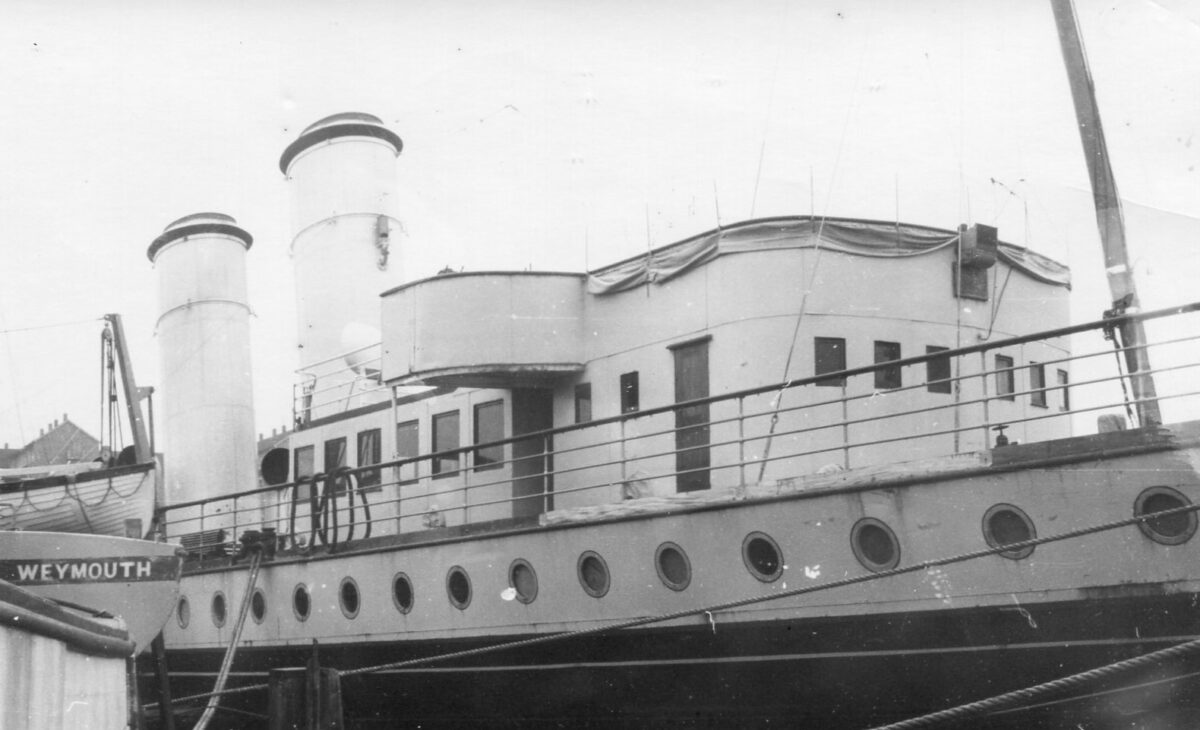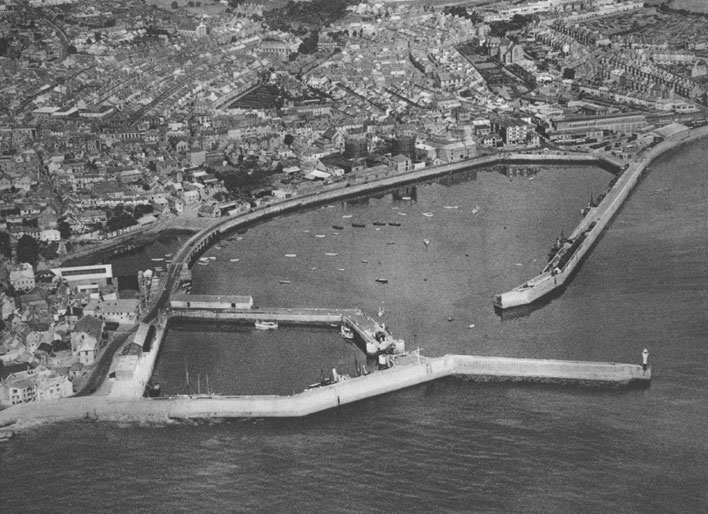
The UK excursion paddle steamer industry reached its apotheosis from the 1890s through to the First World War. The newer steamers, of which P & A Campbell’s Britannia, built 1896, (pictured above) was one, got ever bigger with the biggest ever more luxurious. Routes expanded and competition was fierce. At its height you could have boarded a paddle steamer at Lowestoft and sailed all the way to the Scilly Isles by one paddle steamer after another with changes at Clacton, Southend, Ramsgate, Folkestone, Eastbourne (from where you could have taken a day return to Boulogne,) Brighton, Ryde, Southampton, Bournemouth (from where you could have taken a day trip to Cherbourg or Alderney), Weymouth, Torquay, Plymouth, Falmouth and Penzance. You would have had to study the timetables and pick your dates to make all the connections work for the whole route. And you might have had to spend the odd night or two in one or other resort waiting to board the next paddle steamer for the next leg. But it could have been done. It was the golden age of excursion paddle steamer hopping around our coast.

However, as the steamer services bedded in and owners and operators settled down with a fuller understanding of what worked and what didn’t work, what made money and what didn’t make money, some of the routes, particularly the longer coastal ones in the West Country, were axed. For example you could still have crossed the Channel from the Sussex resorts to Boulogne by paddle steamer right up to 1956 when P & A Campbell’s Glen Gower (pictured above) made the last call. But if you had wanted to go all the way to the Scilly Isles by paddle steamer then you would have had to have done it before 1907 when the Britannia made her last call there on a three day excursion down from the Bristol Channel via Penzance.

Much excitement was therefore generated in late 1962 when a Mr Ian Hextable of Penarth decided to try to recreate the long gone three day trip to the Scilly Isles with a one off charter sailing of P & A Campbells Bristol Queen (pictured above) from Cardiff in 1963.

The ship spent much of that freezing winter at Weymouth undergoing a huge refit by Cosens and Co but, by the time she left in late April, things had moved on with the charterer bowing out and the trip now set to be run by P & A Campbell in their own right.

Fares, as you can see from this leaflet, were quite high for the time with the return from Cardiff to the Scilly Isles set at £9 per head. With the 1963 average wage at around £15 per week, comparable with around £500 per week today, scaling the £9 up to today’s money brings the fare in at a cost of around £300 not including the necessary hotel accommodation in Penzance on the way there and back. For what was in effect a three day/two night mini break this was not a cheap trip.

The Bristol Queen left Cardiff just before 10am on Friday 17th May 1963 under the command of Capt Jack George in fair weather and, calling at Weston on the way down Channel, arrived at Ilfracombe for her scheduled 2pm departure time. Lands End was passed at 7.30pm with an arrival off Penzance around 8pm. There was then a delay of more than an hour waiting to pick up the pilot and for enough water to get in so it was gone 10pm before the Bristol Queen finally tied up alongside the Albert Pier with passengers able to disembark and make their way to their overnight accommodation ashore. I wonder what the Penzance landladies, some of whom might have had dinners waiting and drying out in their ovens, thought of that?

In this picture of Penzance, the Albert Pier is the arm of the harbour extending out from the shore from the top right. As you can imagine, getting a large paddle steamer in and round the right angle bend to this berth was never going to be easy and so it turned out. Almost all the harbour dries out at low tide except for the wet basin in the bottom left which has lock gates and the Scilly Isles ferry Scillonian’s berth which is on the far side of the breakwater sticking out left to right in the foreground. As the night moved on, the water left the Bristol Queen and she ended up high and dry.
As the tide came back up again next morning there was not quite enough water to float her out from the berth at departure time so it was around 11.10am before she finally got away for the thirty five mile trip out into the Atlantic to the Scilly Isles. It was a day of glorious sunshine, ideal paddle steamer weather. St Mary’s was reached at 2.15pm and, after the passengers had disembarked, Bristol Queen went out to anchor to make way for the Scillonian on its routine crossing from Penzance. Departure was at 6.15pm and Penzance was reached at 9.15pm. Again there was not enough water to berth at the Albert Pier, and would not have been until after 11pm, so, rather than wait like the previous night and delay everybody, the Bristol Queen eventually tied up alongside the Scillonian.

Sunday 19th May dawned with the promise of yet another beautiful day and the Bristol Queen was away from Penzance shortly after her scheduled departure time of 9.30am arriving back in Ilfracombe at 5.25pm, Barry at 8.25pm and Weston dead on time at 9.45pm. All in all it had been a lovely weekend with lovely weather reviving a lovely long forgotten paddle steamer route. A joy indeed for paddle steamer enthusiasts.

On her Class IV Passenger Certificate the Bristol Queen could accommodate well over a thousand. But for this 1963 trip to the Scilly Isles, the Board of Trade restricted the numbers to the capacity of her lifeboats which could accommodate just 144 passengers and 41 crew, a total of 185. There had been thoughts of putting more life saving apparatus aboard in the form of the then relatively new concept of inflatable life-rafts which would have enabled her to carry more. But, in retrospect, it is just as well that this wasn’t done as the passenger loading for this unusual trip was just 120.
But 120 passengers at £300 a head in today’s money (if everyone did the whole round trip) is still a tasty £36,000 so the weekend was commercially well worth doing and does show the merit of offering a limited appeal cruise at a high premium fare.
Clifton Smith-Cox, P & A Campbells’s commercially astute Managing Director repeated the adventure the following May and every season after that right up to Bristol Queen’s last year of service in 1967. By then, with the extra life-rafts now taken aboard, Bristol Queen’s special Class III Passenger Certificate from Penzance to the Scilly Islands, valid only from the 10th to the 15th May in 1967, had crept up to 500. Nice one Clifton! But even extra dollops of cash like this could not save what was by then an ailing business model. Although the company staggered on until 1980 initially with their Westward Ho and then with the Balmoral, after 1967 they never again operated a paddle steamer. And never again did a paddle steamer flap its way out into the Atlantic to the Scilly Isles.
Kingswear Castle returned to service in 2023 after the first part of a major rebuild which is designed to set her up for the next 25 years running on the River Dart. The Paddle Steamer Kingswear Castle Trust is now fund raising for the second phase of the rebuild. You can read more about the rebuilds and how you can help if you can here.
John Megoran


